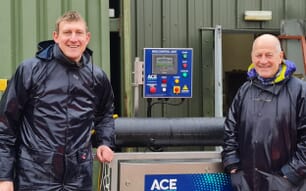Sea lice are among the most economically costly parasites of marine farmed salmonids (Costello, 2009). The annual cost of two sea lice species, Lepeophtheirus salmonis (Krøyer, 1837) and Caligus elongatus (Nordmann, 1832), including harvest losses and therapeutant costs, has been estimated at €300 million globally, which is equivalent to 0.1 to 0.2 € kg−1 fish produced or 6–10% of the total production value (Costello, 2009; Rae, 2002). Sea louse control is therefore critical if productivity is to be maximised. To date, use of veterinary drugs remains a key component of integrated control strategies (Rae, 2002).
This is problematic as, for instance, the UK is restricted in the number of licensed anti-sea lice medicines available and the few therapeutants available are largely becoming less effective due to development of drug resistance by the parasite (Shinn and Bron, 2012). The current study tested an alternative control strategy which relies upon manipulation of fish swimming depth. The life-cycle of salmon lice consists of eight host-associated stages, and two free swimming nauplius stages (Heuch et al., 1995; Pike, 1990). It has been suggested that sea lice larvae remain within the first four metres of the water surface by performing short swimming bursts (Heuch et al., 1995; Hevrøy et al., 2003; Johannessen, 1978; Murray and Gillibrand, 2006). The upward swimming behaviour of lice larvae counters their negative buoyancy; however, copepodids do seem to show diurnal vertical migration (Aarseth and Schram, 1999; Heuch et al., 1995).
The principal cue employed to make contact with swimming fish is the vibration of passing hosts, detected using an array of mechanoreceptors (Bron et al., 1993a; Heuch et al., 2006). Additionally, L. salmonis may also use phototactic cues, such as shadow and potentially light reflection from the scales of host fish, to colonise the host (Bron and Sommerville, 1998; Bron et al., 1993a; Genna et al., 2005). In an earlier small scale trial, infection rate was observed to increase in fish swimming at shallow depths compared to deeper water (Hevrøy et al., 2003). Similarly, another study showed that salmon kept in cageswith deep net pens (20 m depth) had lower louse infection than salmon kept in shallow pens (6 m; Huse and Holm, 1993).
This depth preference of the sea louse larvae may therefore provide an opportunity for sea lice control on salmon farms through the manipulation of salmon swimming behaviour and depth (Oppedal et al., 2011). Salmon swimming behaviour is mainly dictated by environmental factors such as seasonal and daily changes in lighting conditions, temperature, salinity and oxygen, as well as by the mode of feeding employed in a commercial setting (Oppedal et al., 2011). Salmon are positively phototactic and therefore they seek out light sources in order to display their preferred schooling swimming behaviour (Dempster et al., 2009; Juell and Fosseidengen, 2004; Juell et al., 2003; Oppedal et al., 2007).
Naturally, salmon follow a diel swimming rhythm, following ambient light patterns with migration downwards in the water column at dawn and return to surface waters at dusk and through the night (Bjordal et al., 1993; Fernö et al., 1995; Juell and Fosseidengen, 2004; Juell andWesterberg, 1993; Oppedal et al., 2001). Photoperiod regimes acting through the use of high intensity submerged lights, which are routinely used to suppress early sexual maturation in Atlantic salmon during the on-growing phase, impact directly on fish swimming behaviour, with schooling at night around the submerged light units (Oppedal et al., 2007). Strategic deployment of submerged lights can therefore be employed to attract fish to specific water layers (Juell and Fosseidengen, 2004; Juell et al., 2003; Oppedal et al., 2007).
Commercially reared salmon are normally fed a pellet diet through surface spreading and the fish respond by changing swimming speed and direction, showing horizontal and vertical scattering towards the pellets (Ang and Petrell, 1998). The fish will remain up in the water column in the feeding corridor until satiated (Ang and Petrell, 1998; Fernö et al., 1995; Juell et al., 1994). Appetite and feeding are the strongest behavioural cues in fish with regard to swimming behaviour and they usually override any sub-optimal conditions, whether environmentally or artificially induced (e.g. phototaxis or water temperature) (Oppedal et al., 2007).
In the current study, the effects of submerged artificial lighting (placed at 10 m depth) in combination with submerged feeding (delivering feed at 5 m depth) were tested to examine elective salmon swimming depth and associated sea louse infection. The submerged lighting was installed to attract fish to deeper water levels during night time and the submerged feeding was installed to attract salmon away from a surface feeding corridor below the nominal principal infective louse layer.
The hypothesis being tested was that sea lice infection in a commercial salmon population could be reduced by exposure to deep lighting, and further decreased by deep lighting and deep feeding This is based on two assumptions suggested by previous studies, firstly that infective sea louse copepodid larvae remain in the water surface layer and secondly that deep lighting and feeding can be employed to attract salmon to deeper water depths.
February 2015


